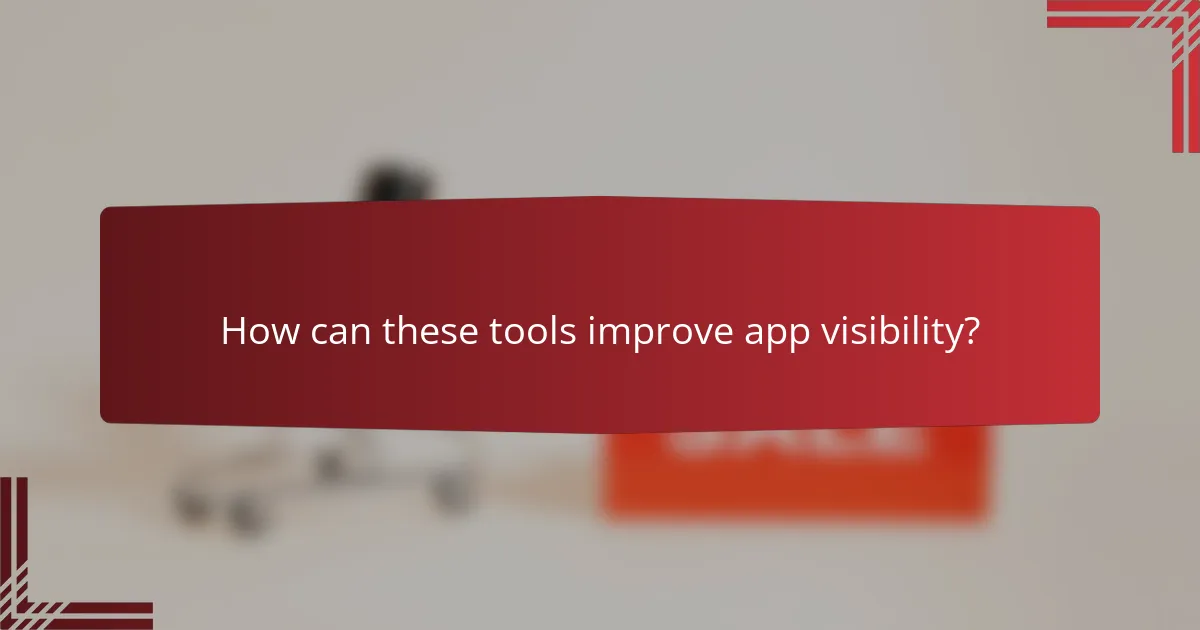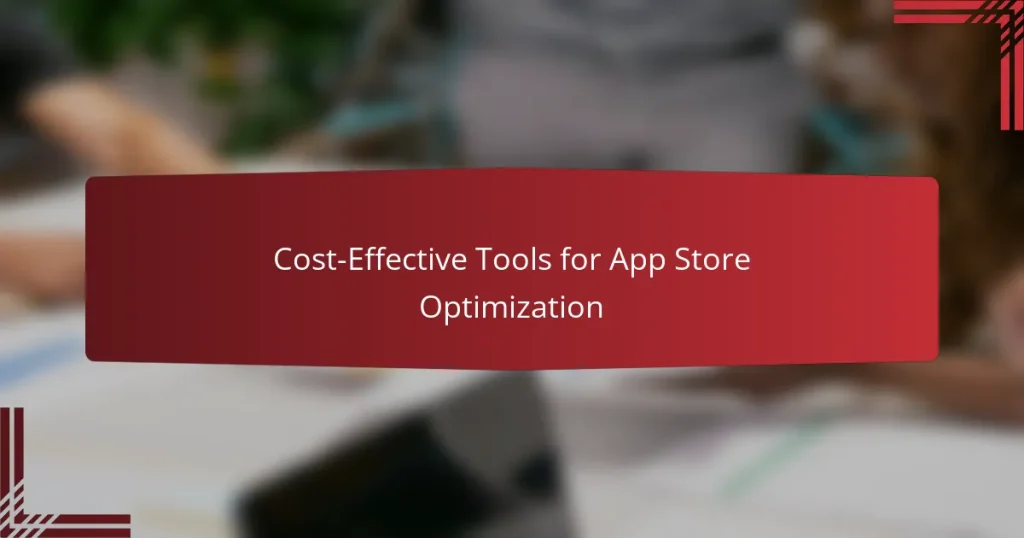Cost-effective tools for App Store Optimization (ASO) are essential for developers looking to boost their app’s visibility and downloads without breaking the bank. By offering insights into keywords, competitor performance, and analytics, these tools enable effective strategies that can significantly enhance an app’s ranking in search results and attract a broader audience.

What are the best cost-effective tools for App Store Optimization?
Cost-effective tools for App Store Optimization (ASO) help developers enhance their app’s visibility and increase downloads without significant financial investment. These tools provide insights into keywords, competitor analysis, and performance metrics, making them essential for effective ASO strategies.
AppTweak
AppTweak is a user-friendly ASO tool that offers keyword research, app store analytics, and competitor insights. It allows you to track your app’s performance over time and optimize your metadata based on real-time data.
Consider using AppTweak for its intuitive interface and comprehensive keyword suggestions. The platform also provides a free trial, making it accessible for developers on a budget.
Sensor Tower
Sensor Tower is a powerful ASO tool that focuses on market intelligence and app analytics. It provides detailed insights into app rankings, keyword performance, and user demographics.
While Sensor Tower offers a range of features, its pricing can vary significantly based on the level of access you need. For those just starting, consider the basic plan to get essential insights without overspending.
Mobile Action
Mobile Action is designed to help developers optimize their app store presence through keyword tracking and competitor analysis. It offers actionable insights that can improve your app’s visibility and conversion rates.
This tool is particularly useful for tracking keyword rankings and understanding market trends. Mobile Action also provides a free version with limited features, allowing you to test its capabilities before committing financially.
Keyword Tool
Keyword Tool specializes in generating keyword suggestions for app store optimization. It helps identify high-traffic keywords relevant to your app, which can enhance your search visibility.
Using Keyword Tool can streamline your keyword research process. It is particularly beneficial for developers looking to refine their app descriptions and titles based on popular search terms.
ASOdesk
ASOdesk offers a suite of features for app store optimization, including keyword tracking, A/B testing, and competitor analysis. It is designed to help developers make data-driven decisions to improve their app’s performance.
This tool is ideal for those who want a comprehensive ASO solution without a hefty price tag. ASOdesk also provides a free trial, allowing you to explore its features before making a financial commitment.

How can these tools improve app visibility?
Cost-effective tools for app store optimization (ASO) enhance app visibility by optimizing keywords, analyzing competitors, and tracking conversion rates. These strategies help apps rank higher in search results, attract more downloads, and ultimately increase revenue.
Keyword optimization
Keyword optimization involves selecting and integrating relevant keywords into your app’s title and description. This process ensures that your app appears in search results when users look for specific terms. Tools like Sensor Tower or App Annie can help identify high-traffic keywords that are less competitive, allowing for better visibility.
When optimizing keywords, focus on a mix of short-tail and long-tail keywords. Short-tail keywords are broader and more competitive, while long-tail keywords are more specific and often have lower search volumes. Aim for a balanced approach to capture a wider audience.
Competitor analysis
Competitor analysis allows you to understand what strategies successful apps in your category are using. By examining their keywords, ratings, and user reviews, you can identify gaps in your own app’s optimization. Tools like Mobile Action can provide insights into competitors’ performance, helping you adjust your strategy accordingly.
Look for patterns in your competitors’ app descriptions and update frequency. If they frequently update their apps with new features or improvements, consider adopting a similar approach to stay competitive. Regularly monitoring your competitors can help you stay ahead in the crowded app marketplace.
Conversion rate tracking
Tracking conversion rates is crucial for understanding how effectively your app’s store page converts visitors into downloads. By analyzing metrics such as click-through rates and download rates, you can identify which elements of your app’s listing are performing well and which need improvement. Tools like AppTweak can assist in this analysis.
To improve conversion rates, consider A/B testing different app icons, screenshots, and descriptions. Small changes can lead to significant increases in downloads. Regularly review your conversion data to make informed adjustments to your app store listing.

What features should I look for in ASO tools?
When selecting App Store Optimization (ASO) tools, focus on features that enhance keyword visibility, provide insightful analytics, and support localization. These capabilities are essential for improving app rankings and reaching diverse user bases effectively.
Keyword research capabilities
Effective keyword research is crucial for optimizing your app’s visibility. Look for tools that offer comprehensive keyword suggestions based on search volume, competition, and relevance. Features like keyword tracking and historical data can help you identify trends and refine your strategy over time.
Consider tools that allow you to analyze competitor keywords as well. This can provide insights into what works in your niche and help you discover untapped opportunities. Aim for tools that update their databases regularly to ensure you have access to the latest information.
App store analytics
App store analytics features provide valuable insights into your app’s performance. Look for tools that track metrics such as downloads, user engagement, and conversion rates. Understanding these metrics can help you assess the effectiveness of your ASO strategies and make data-driven decisions.
Some tools offer A/B testing capabilities, allowing you to experiment with different app icons, descriptions, and screenshots. This can help you determine what resonates best with your audience and optimize your app listing accordingly.
Localization support
Localization support is vital for reaching users in different regions. Choose ASO tools that facilitate keyword translation and cultural adaptation of your app’s metadata. This ensures that your app appeals to local audiences and complies with regional regulations.
Look for tools that provide insights into local market trends and user preferences. This can help you tailor your app’s content and marketing strategies effectively. Additionally, consider tools that support multiple languages to streamline your localization efforts across various markets.

What are the pricing models of popular ASO tools?
Popular App Store Optimization (ASO) tools typically use three main pricing models: subscription-based pricing, freemium models, and one-time purchase options. Each model has its own advantages and considerations, making it essential to choose one that aligns with your budget and needs.
Subscription-based pricing
Subscription-based pricing is a common model for ASO tools, where users pay a recurring fee, often monthly or annually. This model usually provides access to a full suite of features, including keyword tracking, competitor analysis, and performance reports.
Prices can vary significantly, typically ranging from around $20 to several hundred dollars per month, depending on the features and level of service. It’s important to assess whether the tool’s offerings justify the ongoing cost, especially for long-term projects.
Freemium models
Freemium models allow users to access basic features of an ASO tool for free, with the option to upgrade to a paid plan for advanced functionalities. This model is beneficial for those who want to test a tool before committing financially.
While the free version may be limited in features or usage, it can still provide valuable insights for smaller apps or startups. However, users should be cautious of potential upselling tactics that may pressure them into upgrading sooner than needed.
One-time purchase options
One-time purchase options involve a single payment for lifetime access to an ASO tool. This model can be appealing for users who prefer to avoid ongoing fees and want to own the software outright.
Prices for one-time purchases can vary widely, often ranging from $50 to a few hundred dollars. However, users should consider the potential need for updates or additional features, which may not be included in the initial purchase. Always check the terms regarding future support and upgrades before buying.

How do I choose the right ASO tool for my app?
Choosing the right App Store Optimization (ASO) tool involves evaluating your app’s specific needs, budget, and the features offered by various tools. Focus on tools that provide keyword tracking, competitor analysis, and performance metrics to ensure effective optimization.
Assessing budget constraints
When assessing budget constraints for ASO tools, consider both the upfront costs and ongoing expenses. Many tools offer tiered pricing plans, ranging from free versions with limited features to premium subscriptions that can cost hundreds of dollars per month.
Evaluate what features are essential for your app’s success. For instance, if you need comprehensive keyword tracking and analytics, investing in a mid-range tool might be more beneficial than opting for a free version that lacks these capabilities.
Keep in mind that some tools offer trial periods, allowing you to test their features before committing financially. This can help you determine if the tool meets your needs without overspending initially.


